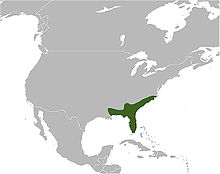Crotalus adamanteus
| Eastern diamondback rattlesnake | |
|---|---|
 |
|
| Scientific classification | |
| Kingdom: | Animalia |
| Phylum: | Chordata |
| Class: | Reptilia |
| Order: | Squamata |
| Suborder: | Serpentes |
| Family: | Viperidae |
| Genus: | Crotalus |
| Species: | C. adamanteus |
| Binomial name | |
|
Crotalus adamanteus Palisot de Beauvois, 1799 |
|
 |
|
| Synonyms | |
|
|
Crotalus adamanteus is a pit viper species found in the southeastern United States. It is the heaviest though not the longest venomous snake in the Americas and the largest rattlesnake. No subspecies are currently recognized.
This is the largest rattlesnake species and is the heaviest known type of venomous snake, with one specimen shot in 1946 measuring 7.8 ft (2.4 m) in length and weighing 15.4 kg (34 lb). However, other venomous snakes may rival this species in weight, the much longer but more slender king cobra is probably greater in average body mass if not maximum weight and the shorter but even bulkier gaboon viper could (but is not verified to) exceed the rattlesnake in both mean adult body mass and possibly even maximum body mass. Maximum reported lengths for eastern diamondback rattlesnakes are 8 ft (2.4 m). and 8.25 ft (2.5 m). However, the stated maximum sizes have been called into question due to a lack of voucher specimens. Males are larger than females.
Specimens over 7 ft (2.1 m) are rare, but well documented. Klauber (1998) included a letter he received from E. Ross Allen in 1953, in which Allen explains how for years he offered a reward of $100, and later $200, for an 8 ft (2.4 m) specimen, dead or alive. The reward was never claimed. He did receive a number of 7 ft (2.1 m) range specimens and some 8 ft (2.4 m) skins, but said such skins can be taken from specimens as short as 6 ft (1.8 m). A 7.3 ft (2.2 m) specimen was caught and killed outside a neighborhood in St. Augustine, Florida in September 2009.
The average size is much less. Specimens are rarely found under 1 foot in length. Lengths of 3.5 to 5.5 ft (1.1 to 1.7 m), and 2.75 to 6 ft (0.8 to 1.8 m) are given. One study found an average length of 5.6 ft (1.7 m) based on 31 males and 43 females. The average body mass is roughly 2.3 kg (5.1 lb). The average weight of 9 laboratory-kept specimens was 2.55 kg (5.6 lb), with a range of 0.8 to 4.9 kg (1.8 to 10.8 lb). Few specimens can exceed 5.12 kg (11.3 lb), although exceptional specimens can weigh 6.7 kg (15 lb) or more.
The scalation includes 25–31 (usually 29) rows of dorsal scales at midbody, 165–176/170–187 ventral scales in males/females and 27–33/20–26 subcaudal scales in males/females, respectively. On the head, the rostral scale is higher than it is wide and contacts two internasal scales. There are 10–21 scales in the internasal-prefrontal region and 5–11 (usually 7–8) intersupraocular scales. Usually, there are two loreal scales between preoculars and the postnasal. There are 12–17 (usually 14–15) supralabial scales, the first of which is in broad contact with the prenasal, and 15–21 (usually 17–18) sublabial scales.
...
Wikipedia

